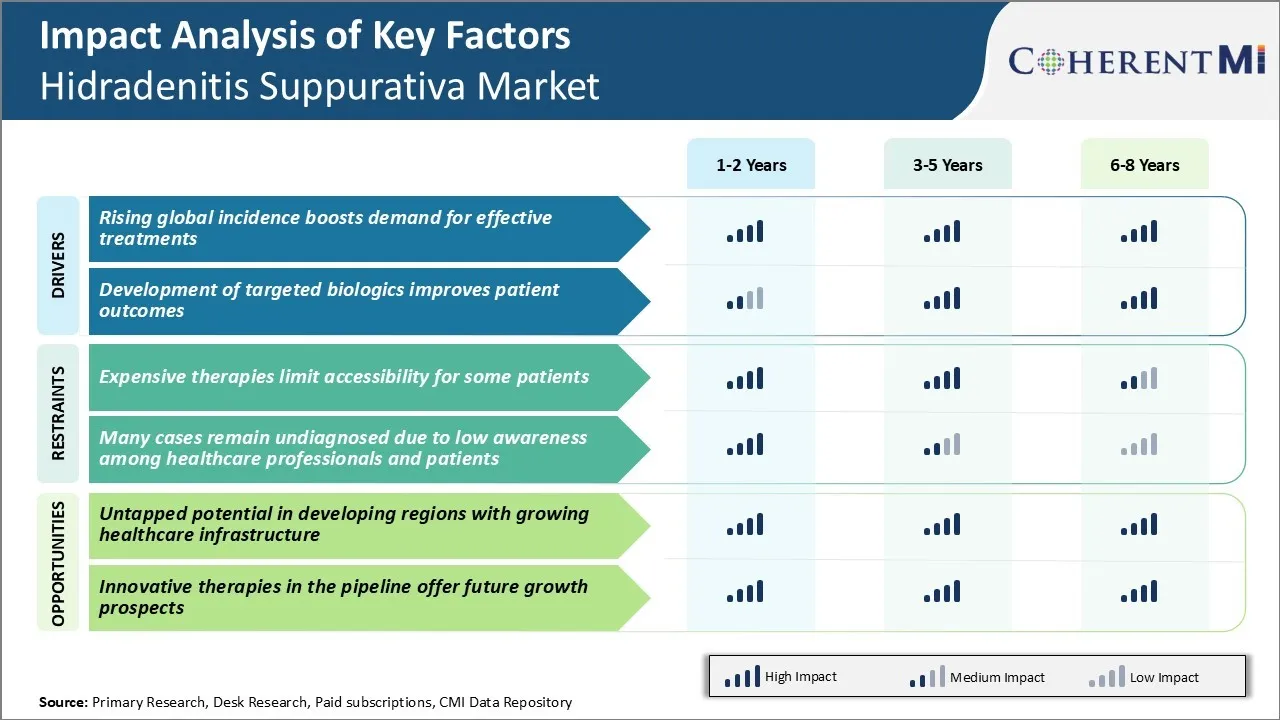Hidradenitis Suppurativa Market Trends
Market Driver - Rising Global Incidence Boosts Demand for Effective Treatments
The worldwide incidence of hidradenitis suppurativa has been steadily increasing over the past few decades. According to dermatologists, about 1-4% of the general population suffers from some form of hidradenitis suppurativa. But only a fraction of them have so far received an accurate diagnosis and treatment. With lifestyle changes making people prone to obesity and smokers at higher risk, the occurrence of HS is bound to increase manifold in the coming years.
Access to better screening and diagnostic techniques will facilitate identification of a greater number of positive cases. As greater clinical awareness translates to earlier interventions, patients can get timely management which can help control progression of the disease. At the same time, insurance coverage for HS therapies is also broadening in many countries.
All these factors cumulatively point towards a growing demand for effective treatment options that can alleviate symptoms and improve quality of life. Pharmaceutical companies and drug developers are responding to this need by committing more investments into innovative research projects. This rising global incidence of HS will continue serving as a major driver for the market in the foreseeable future.
Market Driver - Development of Targeted Biologics Improves Patient Outcomes
Treatment of hidradenitis suppurativa has been a huge challenge for long owing to limited understanding of its pathogenic causes. With no targeted therapies approved earlier, a large proportion experienced frequent disease flare-ups, tunneling and scarring over time. Their physical, mental and social well-being took a significant toll as a result of the inadequately managed chronic disease condition.
Advent of anti-TNF alpha treatments like adalimumab, infliximab and biosimilars has produced groundbreaking results. In several clinical trials, majority of patients achieved clinically meaningful response, remission and improvements in quality of life when administered these targeted biologics. Their novel mechanism of calming overactive immune cells has translated to long-term disease control and symptom relief for both mild and severe HS cases.
Encouraged by this success, pharmaceutical companies continue investing in novel biologic agents with improved pharmacological properties, dosing schedules and safety profiles. A few promising pipeline candidates hold potential to emerge as best-in-class treatments. With available treatment options now addressing the root immunological causes, patient outcomes are looking brighter than ever before. This shift towards highly effective, targeted biologics will certainly revamp the management approach and market developments going forward.

Market Challenge - Expensive Therapies Limit Accessibility for Some Patients
A key challenge faced in the hidradenitis suppurativa market is the high cost of existing treatment options limiting their accessibility for some patients. Hidradenitis Suppurativa is a chronic skin condition that causes painful lumps under the skin. While there are some approved biologic therapies available that have demonstrated effectiveness in managing symptoms, they come with a heavy price tag.
For example, the two leading biologics have average yearly drug costs exceeding $30,000. This steep financial burden poses significant difficulties for many patients without comprehensive health insurance. As Hidradenitis Suppurativa mainly affects patients during their prime working years, lack of insurance coverage is a widespread issue. High deductible plans are also inadequate to cover ongoing biologic prescriptions over the long-term.
The out-of-pocket costs consequently become prohibitive for some lower-income individuals with the disease. This pricing barrier prevents important patient populations from gaining access to therapies that could improve their quality of life by reducing symptoms.
Market Opportunity - Untapped Potential in Developing Regions with Growing Healthcare Infrastructure
One significant opportunity for growth in the hidradenitis suppurativa market is the untapped potential present in developing regions where healthcare infrastructure and access to treatments are improving. While Hidradenitis Suppurativa occurs globally, awareness and diagnosis rates remain low in many emerging markets. This represents a substantial unmet need as better access to care enables more at-risk patient populations to be identified and start appropriate medical management.
As the middle class expands in nations such as China, Brazil, India and others, the ability of private healthcare sectors to provide newly affordable treatments is growing rapidly. This uptick in resources coincides with an expected increase in hidradenitis suppurativa cases secondary to rising obesity and changing lifestyles within developing regions.
First-mover pharmaceutical companies and providers focused on partnering with local clinicians, educators and insurers stand to benefit as these nascent yet large markets mature. Greater penetration into the developing world signifies important long-term revenue opportunities for players addressing the significant unmet need.